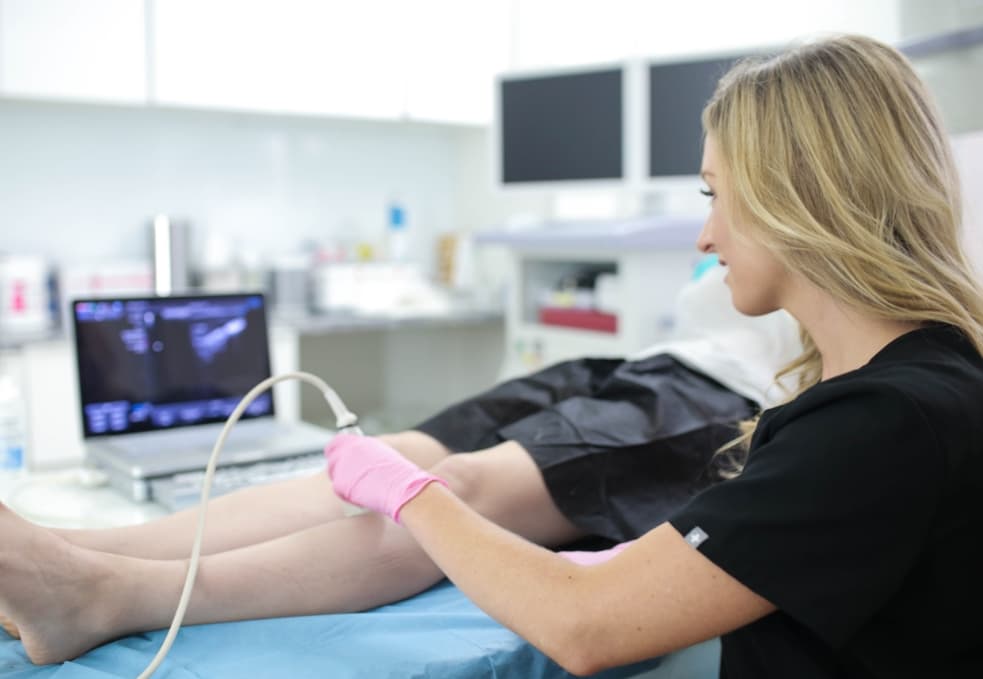Vein injections, also known as sclerotherapy, are a popular treatment for varicose veins and spider veins. If you’re considering this treatment, you might have a few questions about how it works and what to expect. Here are answers to some frequently asked questions about vein injections and other vein treatments.
Before we answer your questions, it’s worth noting that you must visit vein centers for diagnosis and treatment. Our vein centers in Long Island are led by board-certified vein doctors specializing in cutting-edge vein treatments, including sclerotherapy vein injections. You can find our vein centers in West Islip, Jericho, Port Jefferson, and Hampton Bays.
If you’re in or around the north shore, please drive to our vein center at 350 Jericho Turnpike Suite 1A. Please schedule an appointment at your nearest vein center in Long Island.

How long do vein injections last?
The results of vein injections can vary, but they typically last several months to a few years. The treated veins cannot return. However, it’s important to remember that sclerotherapy is not a permanent solution for varicose veins and spider veins — you can still develop new spider veins and varicose veins. If you have a family history of these conditions or other risk factors, you may need additional treatments as new spider veins appear.
How long does it take for varicose veins and spider veins to disappear after sclerotherapy?
The time it takes for treated veins to disappear can vary, but most patients start to see results within a few weeks of their treatment. It can take several weeks or months for the treated veins to fully disappear, depending on the size and severity of the veins. In some cases, multiple treatments may be necessary to achieve the desired results.
Who is a good candidate for spider vein injections?
Sclerotherapy is generally a safe and effective treatment for spider veins, which are small, red, purple, or blue veins visible just under the skin. Good candidates for this treatment include people with healthy skin and good overall health and those with smaller, more superficial veins. If you have larger varicose veins, sclerotherapy may not be the best treatment option for you.
Who is not a candidate for sclerotherapy?
There are a few reasons someone might not be a good candidate for sclerotherapy. If you have a blood clotting disorder or are pregnant, you may not be able to undergo this treatment. People with certain medical conditions, such as heart disease or diabetes, may also be at higher risk of complications from sclerotherapy. If you have any underlying health conditions, it’s important to discuss them with your vein doctor before starting treatment.
Can sclerotherapy injections treat larger veins?
While sclerotherapy can be effective for treating smaller spider veins and some varicose veins, it is generally not recommended for larger veins. If you have larger veins, your vein doctor may recommend other treatment options, such as laser ablation or radiofrequency ablation, to address the root cause of varicose veins and remove the visible veins.
How permanent is sclerotherapy?
Sclerotherapy is considered a permanent procedure, but that doesn’t mean you’ll never get spider veins again. Sclerotherapy permanently destroys and removes unhealthy spider veins, but you can still develop new spider veins, especially if your vein doctor doesn’t address the root cause of spider veins or if you have a high risk. Our vein doctors always offer personalized, minimally invasive treatments to address the root cause of spider veins, thus minimizing the risk of spider vein recurrence. But even so, you may still develop new spider veins.
How often do you need sclerotherapy?
The frequency of sclerotherapy treatments can vary depending on the size and severity of the veins being treated and your response to treatment. Some patients may see the desired results after just one treatment, while others may need multiple treatments to achieve the desired outcome. In general, waiting at least six weeks between sclerotherapy treatments is recommended to allow the treated veins to fully resolve.
Compression stockings are typically recommended after sclerotherapy to reduce swelling and improve circulation in the treated area. If you don’t wear compression stockings after sclerotherapy, you may risk developing blood clots or other complications. It’s important to follow your vein doctor’s instructions and wear the recommended compression stockings for the recommended amount of time to ensure the best possible results.
What not to do after sclerotherapy?
After sclerotherapy, it’s important to avoid activities that may increase the pressure in your veins, such as heavy lifting or vigorous exercise. You should also avoid hot baths or showers, saunas, and sunbathing for at least 24 hours after treatment. It’s also important to avoid scratching or rubbing the treated area, as this can cause irritation and potentially disrupt the healing process.
How to prevent varicose veins and spider veins from returning?
While there is no surefire way to prevent varicose veins and spider veins from returning after sclerotherapy, there are steps you can take to reduce your risk of developing these conditions. Some things you can do to prevent varicose veins and spider veins from returning include:
- Staying active and exercising regularly
- Maintaining a healthy weight
- Wearing comfortable, supportive shoes
- Avoiding high heels and tight clothing
- Avoiding prolonged periods of standing or sitting
- Elevating your legs when possible
If you have a family history of varicose veins or other risk factors, discuss prevention strategies with your vein doctors. They can help you develop a plan to reduce your risk of developing these conditions and keep your veins healthy and free of visible veins.

